New Report Estimates Domes Cost
$64 million to replace or $14 to $54 million for repair approaches. Abele may favor relocation.
A recently released report by GRAEF USA about options for the Mitchell Park Horticultural Conservatory, popularly known as the Domes, offers relatively good news. The 62-page report estimates five repair options that range in price from $14 million to $54 million. Completely rebuilding the Domes, a new option, would cost $11 million less than a recent $75-million projection. The report also presents a new catch-all category of other-shaped conservatories — estimated at $50 to $70 million, not including design or site costs.
The “2016 Update on Costs and Options for Domes” was released by County Executive Chris Abele, who has said he wants “all options on the table,” including demolition of the Domes. To that end, the new “domed” or “non-domed” glasshouses could be built at unspecified sites, the report notes. A disclaimer states that besides potential land-acquisition costs, new-structure estimates “are very susceptible to significant variances due to the large number of unknown factors that may affect costs,” including “Architectural design, site preparation, soil conditions, and infrastructure (water, sewer, electric)…”
One repair approach in the report would revamp the cone-shaped, 85-foot Domes with rounded “geodesic” ones up to 15 feet shorter, similar to geodesic-dome conservatories in Des Moines, Omaha and St. Louis, which resemble half balls. The report notes they have less surface glass to maintain but would not accommodate some existing tall plants. One of Domes’ architect Donald Grieb’s stated goals for his design was allowing for giant plants. The report does acknowledge the plant collection’s value, which has been estimated at $3.4 million.
Graef was paid $46,400 for the report, according to the comptroller’s office. Three county staffers and nine consulting professionals were on the team. The National Trust for Historic Preservation will fund a peer review of GRAEF’s engineering report.
Report Differs from Earlier Domes Planning
The GRAEF report’s five estimates of different repair costs is actually an update of a 2008 report on the Domes overseen by Walter Wilson, Milwaukee County’s former principal architect. That report was the culmination of a two-year Domes planning process, working with GRAEF. The team included seven county staffers and 14 outside professionals. National experts were contacted and the emphasis was on preserving the domes. Options to replace them were not considered. The study included Part 1 and Part 2.
The 2008 study listed these “Conservatory Goals”:
- To maintain “The Domes” as a jewel of Milwaukee County Parks infrastructure.
- To maintain the invaluable investment in horticultural species.
- To maintain the facility as a “must-see and must-experience” destination for SE Wisconsin residents and visitors.
- To increase public usage, and use of the facility for business and private gatherings.
- To increase revenue, decrease operating costs, and promote “The Domes” self-sufficiency.
- To expand educational opportunities.
Additionally, ten Project Goals included:
- To eliminate the water leaks into the Show Dome.
- To lower the operating expenses…through improvements in energy efficiency.
- To improve the ease of…maintenance and lower…costs of replacing and cleaning the glass.
- To provide the most cost-effective, long-term repair and/or replacement options.
- To maintain the unique visual design of the facility.
- To improve the climate within [the Domes] for the well-being of plants, wildlife and visitors.
Wilson says of his team’s study: “We wanted to give politicians thorough information to help them make rational decisions about this valuable resource.” Nonetheless, after the findings were presented in October 2008, he laments, “The study went into a drawer and was never talked about again.” Wilson retired in 2013.
Wilson takes issue with the idea of ditching the distinctive-shaped Domes. “Why would you want to replace something that is unique with something that is not?” he says. “These Domes are recognizable symbols of Milwaukee.” Friends of the Domes call them “the world’s only conoidal glass houses.”
Location Issues
Abele is open to a new location for the Domes or a replacement that could be quite different. A recent press release by him notes, “We have a once in a generation opportunity to dream big…The facility may be located at Mitchell Park, near the current Domes, or in a completely new location.”
Abele recently told OnMilwaukee, “We’ve also thought about having the zoo fill these [horticultural] needs…there’s a ton of parking that’s highly visible” at the zoo (at 10001 W. Bluemound Rd.). Options in a GRAEF-designed survey include razing the Domes and consolidating all horticultural activities at Boerner Botanical Gardens in Hales Corners or repurposing the Domes for other uses.
Wilson was named a fellow by the American Institute of Architects, and a “citizen architect” for volunteer work in the urban community. He noted that the Saturday Winter Farmers’ Market, “which is just in its infancy” and Music Under Glass (on hiatus for 2017) are drawing more people to the Domes and South Side. “And how many weddings and wedding photos are done there?” he asked. “Why would anyone want to give up something that’s truly a defining feature of Milwaukee?”
Wilson thinks this debate also reflects larger urban-planning issues playing out in Milwaukee. “Look where the Domes are located. Part of the reasoning behind talk of moving them is that they are in a neighborhood that gives some people pause,” with some low-income residents. He notes Milwaukee’s tendency to “try to put a mask on poverty, as Matthew Desmond’s bestseller Evicted describes.” Wilson believes it would be better to explore ways to restore both the Domes and the neighborhood.
Sustainability & Biodiversity
The update says all but one plan would decrease upkeep and energy costs. Repair estimates were based on double-paned, insulated and laminated glass specified by Super Sky Enterprises, LLC, the Domes’ original glass supplier. A preliminary energy study “indicates that the Mitchell Park Domes would realize a savings of approximately $110,000 per year with the insulated glass, assuming no changes to the current HVAC system.”
Details on Various Current Options
The Domes’ feature glass within aluminum framing attached to a poured-concrete armature. Five options would retain the original foundation:
- Option 1: Replace Broken Glass – Repair Façade and Concrete Frame: $14 million
- Option 2: Replace All Glass – Repair Façade and Concrete Frame: $38 million
- Option 3: Replace All Glass and Install New Façade – Support on Repaired Concrete: $47 million
- Option 4: Install New Glass and Self-Supporting Façade and Repair Concrete: $54 million
- Option 5: Install New Glass and Self-Supporting Façade (in a Geodesic Dome Shape) and Remove Concrete: $50 million
Two other options:
- Option R: “Reconstruction”– Replace All Glass– Install New Façade – Rebuild New Concrete Frame on existing concrete foundation. (Replace mechanical systems.)
- Other Options: New Facility on a New Site, either at Mitchell Park or an alternate location, with a domed or non-domed shape: $50 – $70 million (Estimate excludes additional unknown costs that could be “significant.”)
Next Domes Task Force meeting: Wednesday, January 4, 5:30 p.m., Domes lobby. The public may briefly address agenda items, which will include GRAEF’s studies.



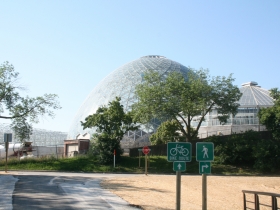
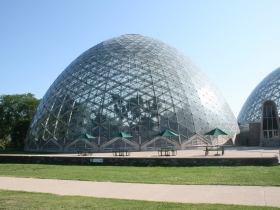
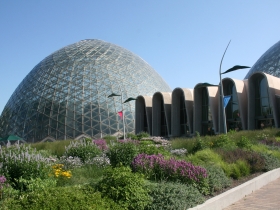
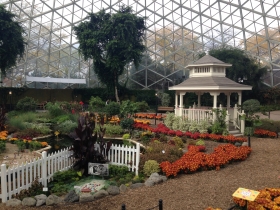

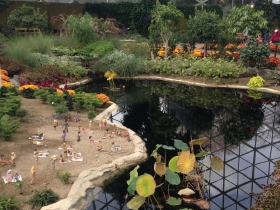















Here is another alternative approach. Try something different. Think big. Make the Domes and Mitchell Park the heart of Milwaukee’s horticultural community/Green Zone and a significant destination for visitors and residents. How? (1) Repair/revitalize the Domes; (2) Recreate a version of the Sunken Gardens and Fountains; (3) Make the communities to the south and west the Green Zone, with friendly competition for the most beautiful block; (4) Plant lots of trees; (5) Engage community schools and NFPs like Journey House to focus on environmental/horticultural education linked to the Domes and specific blocks; (5) create apprenticeships for training; (6) And, most important, create a not-for-profit entity to effectively fund-raise, market and manage the Domes and all of the related programs.